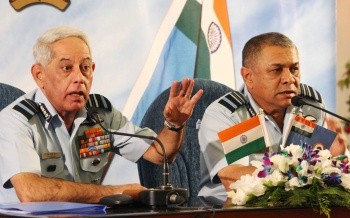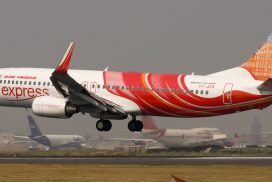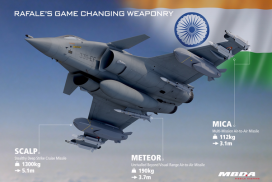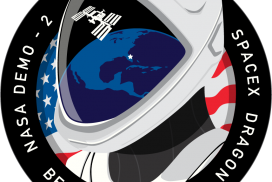 “It’s the biggest fighter aircraft deal since the early 1990s,” said Boeing’s Mark Kronenberg, who runs the company’s Asia-Pacific business as India’s plans a multi-billion dollar jet fighter buy is a contest between Dassault, Saab, MiG, American competitors Lockheed Martin and Boeing and EADS’ Eurofighter. But there were endless delays. At last finally two European competitors European consortium’s Eurofighter and French Dassault’s Rafale were asked to extend the commercial bids for the 126 Medium Multi Role Combat Aircraft that are due to expire on 28th April.
“It’s the biggest fighter aircraft deal since the early 1990s,” said Boeing’s Mark Kronenberg, who runs the company’s Asia-Pacific business as India’s plans a multi-billion dollar jet fighter buy is a contest between Dassault, Saab, MiG, American competitors Lockheed Martin and Boeing and EADS’ Eurofighter. But there were endless delays. At last finally two European competitors European consortium’s Eurofighter and French Dassault’s Rafale were asked to extend the commercial bids for the 126 Medium Multi Role Combat Aircraft that are due to expire on 28th April.
As India rejects U.S. bids for the multi-billion dollar order of Fighter Jets, Boeing released the following statement on the government of India’s Medium Multi-Role Combat Aircraft (MMRCA) decision:
“Boeing today was notified that our Super Hornet proposal for India’s MMRCA competition was not short listed in the initial down select. We are obviously disappointed with this outcome. Our next step is to request and receive a debrief from the Indian Air Force. Once we have reviewed the details, we will make a decision concerning our possible options, always keeping in mind the impact to the Indian Air Force. We believe we offered the Indian Air Force a fully compliant and best-value multi-role aircraft for the defined mission. We will continue to look for opportunities to help India modernize its armed services and enhance its aerospace industry”.
The decision was a blow for the President Obama, who had pushed hard for defense deal during his visit to India in November as part of his agenda broaden the United States relationship with India.
SAAB was also informed by the Indian Ministry of Defence that Gripen has not been shortlisted for the Indian Medium Multi-Role Combat Aircraft (MMRCA) programme. Saab President and CEO Håkan Buskhe said, “We are offering India a world class next generation fighter aircraft to a very competitive price and an extensive technology transfer programme. We have received this decision and will closely monitor the future process and provide additional information if requested by the Indian Ministry of Defence. We are confident that the Gripen system is the perfect match for the Indian Air Force as well as meeting the highest requirements for the international markets”. Saab also mentions that India one of their most important markets. For example, Saab recently announced an investment in a research and development centre in India. Currently Gripen is in service with the Swedish, Czech Republic, Hungarian, South African and Royal Thai Air Forces.
After global aerospace defence giants Boeing, Lockheed Martin, Saab and MiG have lost out on what was the biggest fighter aircraft deal since the early 1990s the European consortium’s Eurofighter and French Dassault’s Rafale are asked to extend the commercial bids for the 126 Medium Multi Role Combat Aircraft that are due to expire on Thursday. The move could be interpreted as ‘down selection’ from six competitors in the $11-Billion deal that is expected to be finalised this fiscal. Sources in the government told The Hindu that the Ministry dispatched the letter, based on the Technical Evaluation Committee’s report. As per the terms of the deal, the competitors would have to show that they have the requisite tie-ups to fulfill the 50-per cent offset clause, which means that half of the value of the deal would have be sourced from Indian companies.
The Indian Air Force had handed over its report to the Ministry last year after rigorous and extensive flight evaluation trials of the six fighter planes bidding for the deal. The sources said the Ministry’s team undertook an elaborate exercise to determine the offset obligations of the competitors, and once the task was complete, the next stage would be determined on the basis of the technical evaluation.
European Consortium’s Eurofighter and French Dassault’s Rafale were at last the two jets to make to the final two. The Rafale has the advantage of being logistically and operationally similar to the Mirage 2000, which the IAF already operates and used with great success during the Kargil War. This would require fewer changes in the existing infrastructure of the IAF, which in turn will reduce cost. Moreover, being 100 per cent French also provided Dassault a distinct edge over its competitors on the issue of technology transfer. Dassault claims that the Rafale has an advantage over many of the competitors because it is not subject to ITAR (International Traffic in Arms Regulations) restrictions. Dassault has also offered to fit the Kaveri engine into the Rafale, which, if chosen, would greatly improve commonality with the LCA Tejas aircraft. The French government has also cleared full technology transfer of the Rafale to India, including that of the RBE2-AA Active Electronically Scanned Array (AESA) radar. France also agreed to transfer software source codes, which will allow Indian scientists to re-programme a radar or any sensitive equipment if needed.
Eurofighter is offering the Tranche-3 Typhoon for the Indian requirement, equipped with the Captor-E (CAESAR) AESA radar. EADS has also invited India to become a partner of the Eurofighter Typhoon programme if the Typhoon wins the contract, and will be given technological and development participation in future tranches of the Typhoon. Bernhard Gerwert, CEO of EADS Defense Department, elaborated that if India becomes the fifth partner of the Eurofighter programme, it will be able to manufacture assemblies for new Eurofighters. EADS also offered to include thrust vectoring nozzles (TVNs) with the Typhoon’s EJ200 engines for India. Thrust vectoring will improve operational capabilities, and reduce fuel burn by up to 5 percent and increase thrust while supersonic cruising by 7 percent. At Aero India 2011 Eurofighter and partner company BAE Systems unveiled for the first time more details about the studies carried out for the initial definition of the navalised version of the Typhoon which could be offered to the Indian Navy.



